Financial Analysis of Roast Ltd. and Investment Appraisal Report
VerifiedAdded on 2023/01/17
|17
|4576
|1
Report
AI Summary
This report presents a comprehensive financial analysis of Roast Ltd., focusing on its performance and potential for acquisition by Starbucks. It begins with an executive summary highlighting key findings from the profit and loss statement, which shows increasing net profits, and the company's ability...
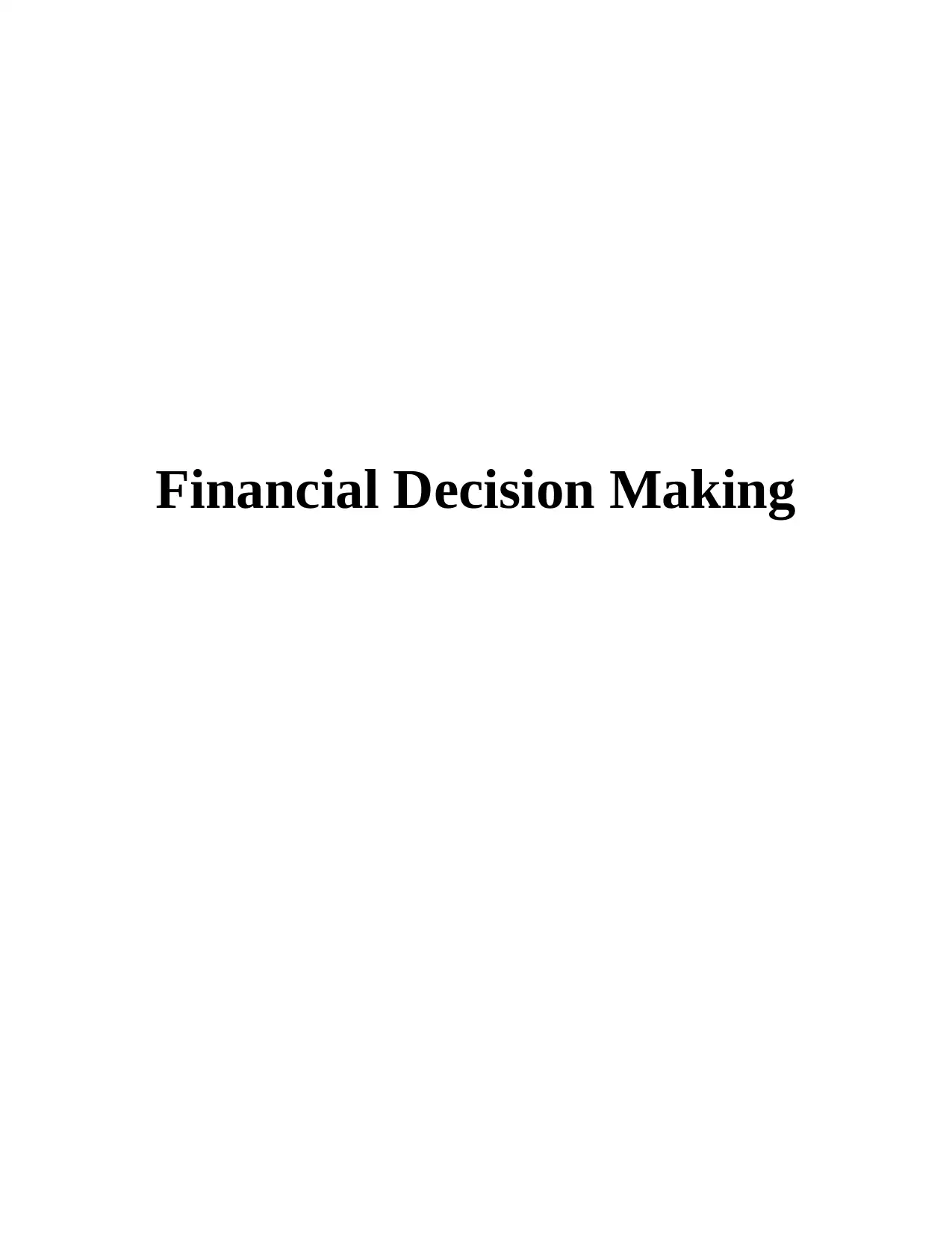
Financial Decision Making
Paraphrase This Document
Need a fresh take? Get an instant paraphrase of this document with our AI Paraphraser

Table of Contents
EXECUTIVE SUMMARY.............................................................................................................1
Part 1: Industry Review...................................................................................................................1
Part 2: Business Performance Analysis...........................................................................................2
2.1 Statement of Profit or Loss...................................................................................................2
2.2 Statement of Financial Position............................................................................................4
2.3 Statement of Cash Flows.......................................................................................................6
Part 3: Investment Appraisal and Sources of Finance.....................................................................8
3.1 Investment Appraisal............................................................................................................8
3.2. Sources of Finance.............................................................................................................10
REFERENCES..............................................................................................................................12
EXECUTIVE SUMMARY.............................................................................................................1
Part 1: Industry Review...................................................................................................................1
Part 2: Business Performance Analysis...........................................................................................2
2.1 Statement of Profit or Loss...................................................................................................2
2.2 Statement of Financial Position............................................................................................4
2.3 Statement of Cash Flows.......................................................................................................6
Part 3: Investment Appraisal and Sources of Finance.....................................................................8
3.1 Investment Appraisal............................................................................................................8
3.2. Sources of Finance.............................................................................................................10
REFERENCES..............................................................................................................................12

You're viewing a preview
Unlock full access by subscribing today!
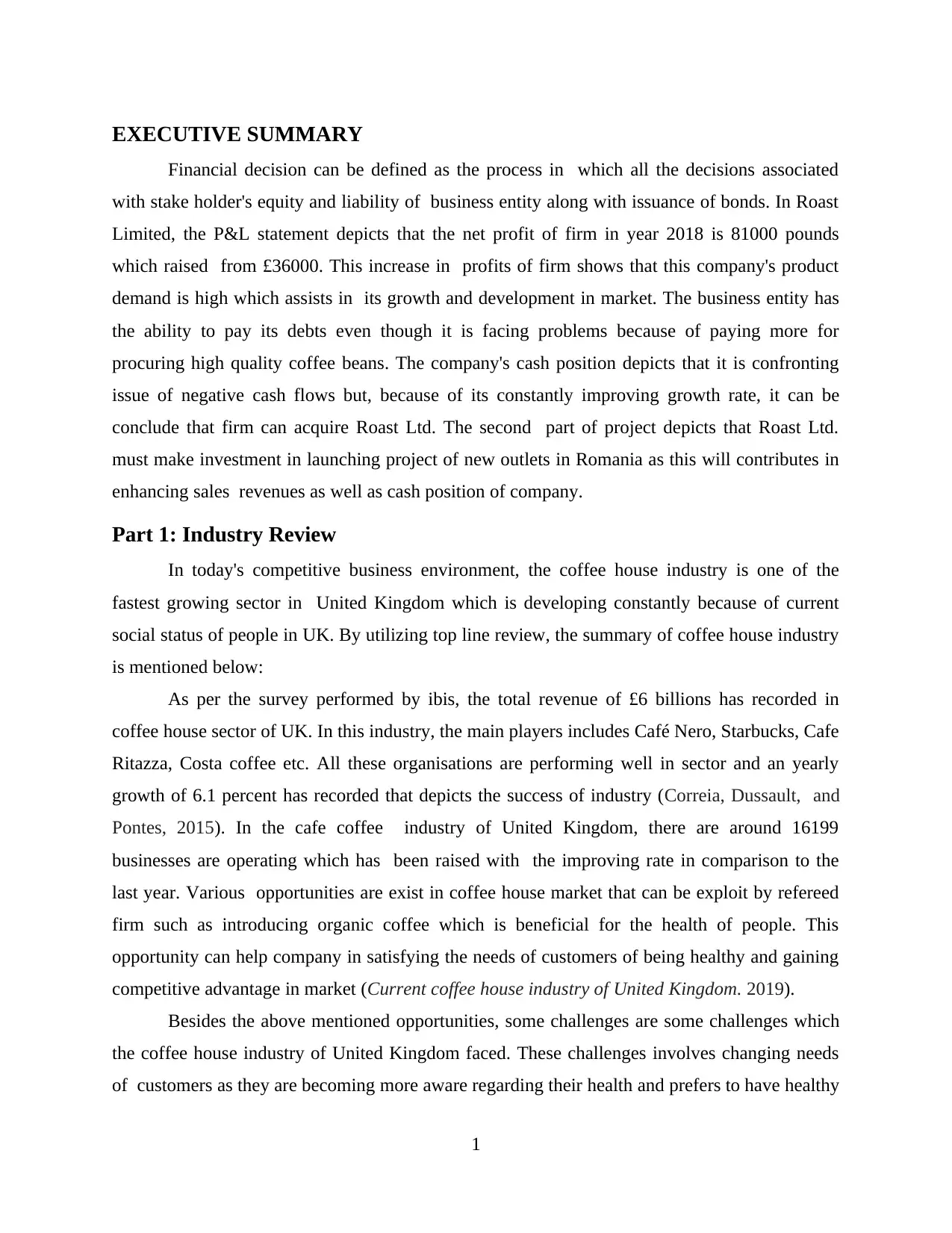
EXECUTIVE SUMMARY
Financial decision can be defined as the process in which all the decisions associated
with stake holder's equity and liability of business entity along with issuance of bonds. In Roast
Limited, the P&L statement depicts that the net profit of firm in year 2018 is 81000 pounds
which raised from £36000. This increase in profits of firm shows that this company's product
demand is high which assists in its growth and development in market. The business entity has
the ability to pay its debts even though it is facing problems because of paying more for
procuring high quality coffee beans. The company's cash position depicts that it is confronting
issue of negative cash flows but, because of its constantly improving growth rate, it can be
conclude that firm can acquire Roast Ltd. The second part of project depicts that Roast Ltd.
must make investment in launching project of new outlets in Romania as this will contributes in
enhancing sales revenues as well as cash position of company.
Part 1: Industry Review
In today's competitive business environment, the coffee house industry is one of the
fastest growing sector in United Kingdom which is developing constantly because of current
social status of people in UK. By utilizing top line review, the summary of coffee house industry
is mentioned below:
As per the survey performed by ibis, the total revenue of £6 billions has recorded in
coffee house sector of UK. In this industry, the main players includes Café Nero, Starbucks, Cafe
Ritazza, Costa coffee etc. All these organisations are performing well in sector and an yearly
growth of 6.1 percent has recorded that depicts the success of industry (Correia, Dussault, and
Pontes, 2015). In the cafe coffee industry of United Kingdom, there are around 16199
businesses are operating which has been raised with the improving rate in comparison to the
last year. Various opportunities are exist in coffee house market that can be exploit by refereed
firm such as introducing organic coffee which is beneficial for the health of people. This
opportunity can help company in satisfying the needs of customers of being healthy and gaining
competitive advantage in market (Current coffee house industry of United Kingdom. 2019).
Besides the above mentioned opportunities, some challenges are some challenges which
the coffee house industry of United Kingdom faced. These challenges involves changing needs
of customers as they are becoming more aware regarding their health and prefers to have healthy
1
Financial decision can be defined as the process in which all the decisions associated
with stake holder's equity and liability of business entity along with issuance of bonds. In Roast
Limited, the P&L statement depicts that the net profit of firm in year 2018 is 81000 pounds
which raised from £36000. This increase in profits of firm shows that this company's product
demand is high which assists in its growth and development in market. The business entity has
the ability to pay its debts even though it is facing problems because of paying more for
procuring high quality coffee beans. The company's cash position depicts that it is confronting
issue of negative cash flows but, because of its constantly improving growth rate, it can be
conclude that firm can acquire Roast Ltd. The second part of project depicts that Roast Ltd.
must make investment in launching project of new outlets in Romania as this will contributes in
enhancing sales revenues as well as cash position of company.
Part 1: Industry Review
In today's competitive business environment, the coffee house industry is one of the
fastest growing sector in United Kingdom which is developing constantly because of current
social status of people in UK. By utilizing top line review, the summary of coffee house industry
is mentioned below:
As per the survey performed by ibis, the total revenue of £6 billions has recorded in
coffee house sector of UK. In this industry, the main players includes Café Nero, Starbucks, Cafe
Ritazza, Costa coffee etc. All these organisations are performing well in sector and an yearly
growth of 6.1 percent has recorded that depicts the success of industry (Correia, Dussault, and
Pontes, 2015). In the cafe coffee industry of United Kingdom, there are around 16199
businesses are operating which has been raised with the improving rate in comparison to the
last year. Various opportunities are exist in coffee house market that can be exploit by refereed
firm such as introducing organic coffee which is beneficial for the health of people. This
opportunity can help company in satisfying the needs of customers of being healthy and gaining
competitive advantage in market (Current coffee house industry of United Kingdom. 2019).
Besides the above mentioned opportunities, some challenges are some challenges which
the coffee house industry of United Kingdom faced. These challenges involves changing needs
of customers as they are becoming more aware regarding their health and prefers to have healthy
1
Paraphrase This Document
Need a fresh take? Get an instant paraphrase of this document with our AI Paraphraser
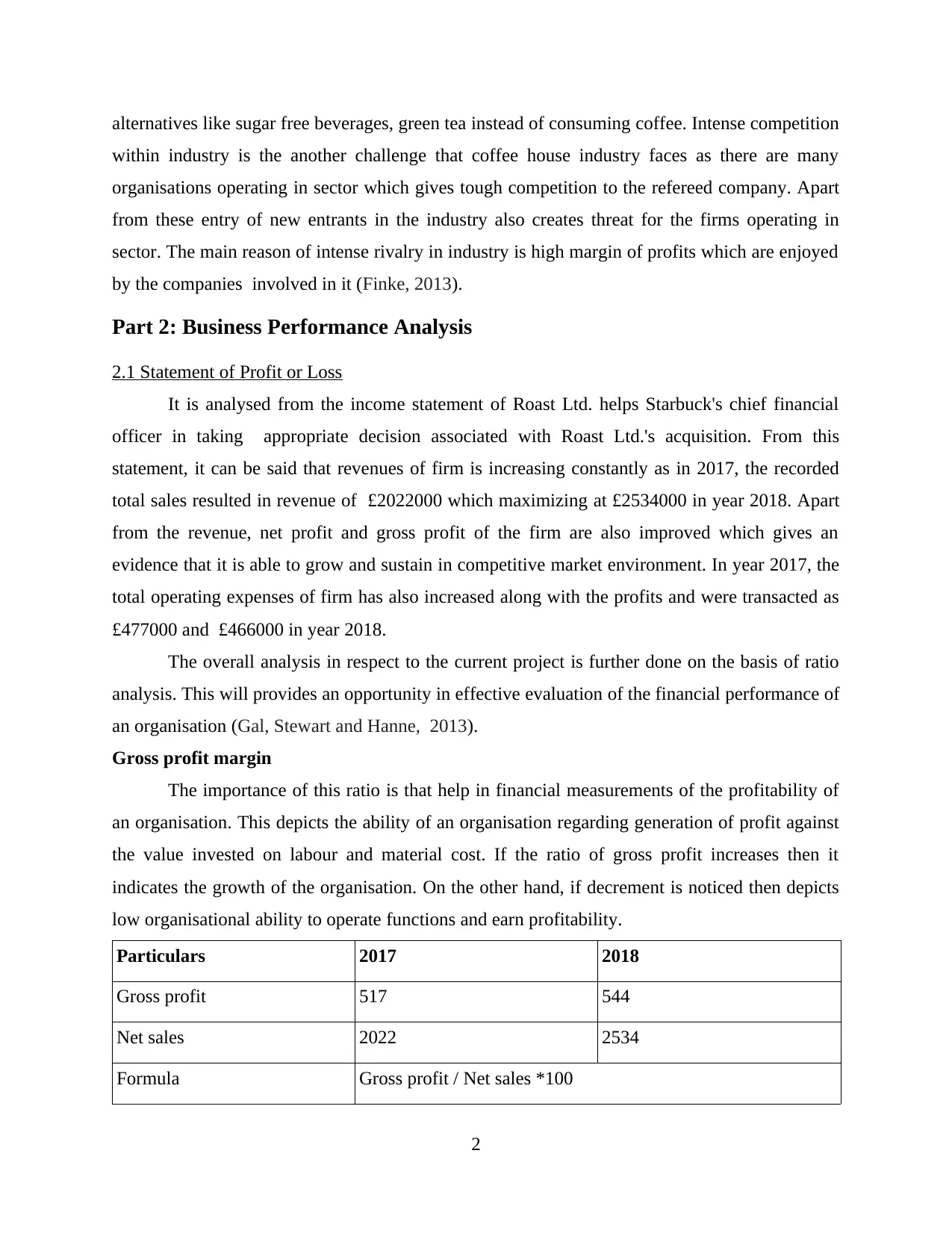
alternatives like sugar free beverages, green tea instead of consuming coffee. Intense competition
within industry is the another challenge that coffee house industry faces as there are many
organisations operating in sector which gives tough competition to the refereed company. Apart
from these entry of new entrants in the industry also creates threat for the firms operating in
sector. The main reason of intense rivalry in industry is high margin of profits which are enjoyed
by the companies involved in it (Finke, 2013).
Part 2: Business Performance Analysis
2.1 Statement of Profit or Loss
It is analysed from the income statement of Roast Ltd. helps Starbuck's chief financial
officer in taking appropriate decision associated with Roast Ltd.'s acquisition. From this
statement, it can be said that revenues of firm is increasing constantly as in 2017, the recorded
total sales resulted in revenue of £2022000 which maximizing at £2534000 in year 2018. Apart
from the revenue, net profit and gross profit of the firm are also improved which gives an
evidence that it is able to grow and sustain in competitive market environment. In year 2017, the
total operating expenses of firm has also increased along with the profits and were transacted as
£477000 and £466000 in year 2018.
The overall analysis in respect to the current project is further done on the basis of ratio
analysis. This will provides an opportunity in effective evaluation of the financial performance of
an organisation (Gal, Stewart and Hanne, 2013).
Gross profit margin
The importance of this ratio is that help in financial measurements of the profitability of
an organisation. This depicts the ability of an organisation regarding generation of profit against
the value invested on labour and material cost. If the ratio of gross profit increases then it
indicates the growth of the organisation. On the other hand, if decrement is noticed then depicts
low organisational ability to operate functions and earn profitability.
Particulars 2017 2018
Gross profit 517 544
Net sales 2022 2534
Formula Gross profit / Net sales *100
2
within industry is the another challenge that coffee house industry faces as there are many
organisations operating in sector which gives tough competition to the refereed company. Apart
from these entry of new entrants in the industry also creates threat for the firms operating in
sector. The main reason of intense rivalry in industry is high margin of profits which are enjoyed
by the companies involved in it (Finke, 2013).
Part 2: Business Performance Analysis
2.1 Statement of Profit or Loss
It is analysed from the income statement of Roast Ltd. helps Starbuck's chief financial
officer in taking appropriate decision associated with Roast Ltd.'s acquisition. From this
statement, it can be said that revenues of firm is increasing constantly as in 2017, the recorded
total sales resulted in revenue of £2022000 which maximizing at £2534000 in year 2018. Apart
from the revenue, net profit and gross profit of the firm are also improved which gives an
evidence that it is able to grow and sustain in competitive market environment. In year 2017, the
total operating expenses of firm has also increased along with the profits and were transacted as
£477000 and £466000 in year 2018.
The overall analysis in respect to the current project is further done on the basis of ratio
analysis. This will provides an opportunity in effective evaluation of the financial performance of
an organisation (Gal, Stewart and Hanne, 2013).
Gross profit margin
The importance of this ratio is that help in financial measurements of the profitability of
an organisation. This depicts the ability of an organisation regarding generation of profit against
the value invested on labour and material cost. If the ratio of gross profit increases then it
indicates the growth of the organisation. On the other hand, if decrement is noticed then depicts
low organisational ability to operate functions and earn profitability.
Particulars 2017 2018
Gross profit 517 544
Net sales 2022 2534
Formula Gross profit / Net sales *100
2
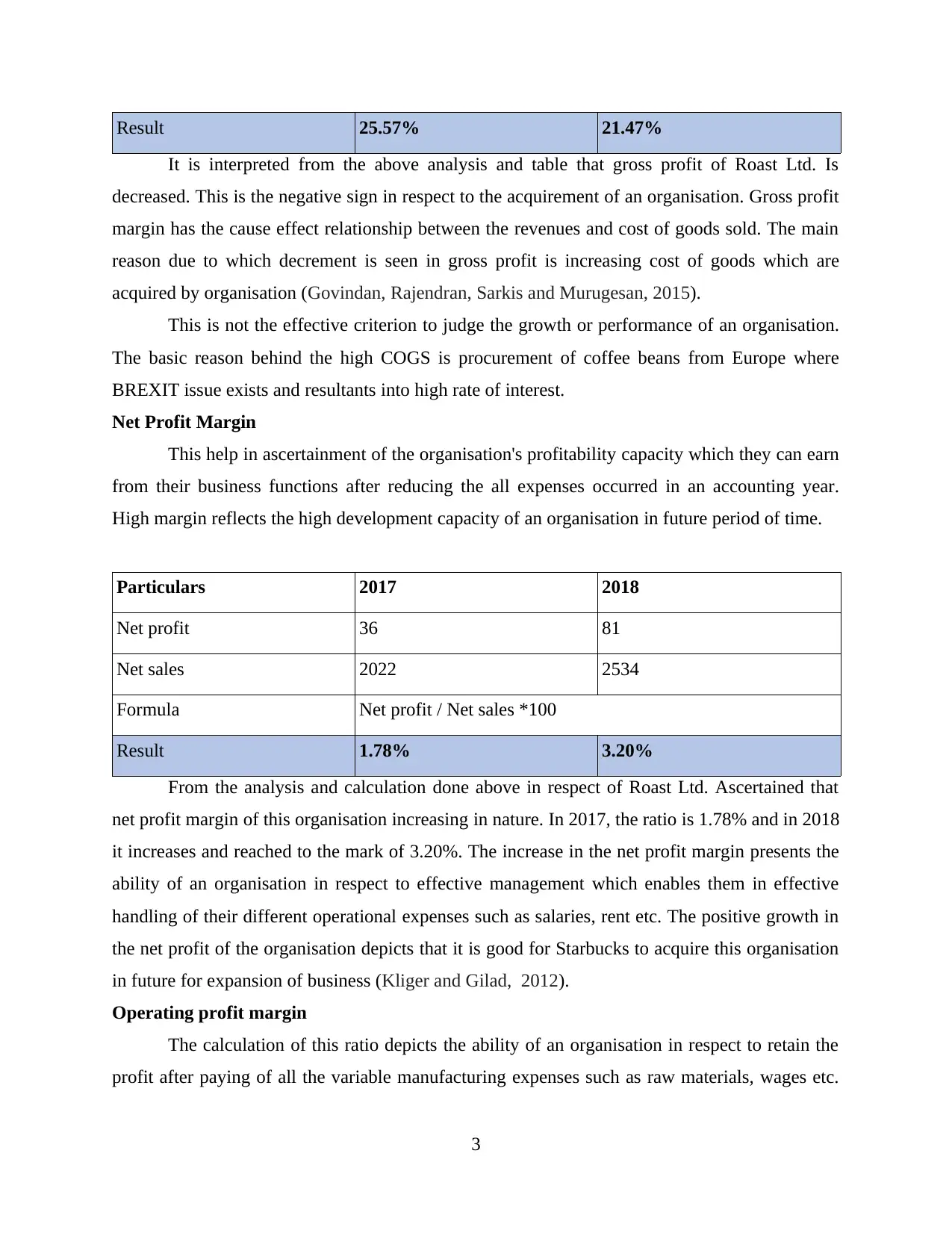
Result 25.57% 21.47%
It is interpreted from the above analysis and table that gross profit of Roast Ltd. Is
decreased. This is the negative sign in respect to the acquirement of an organisation. Gross profit
margin has the cause effect relationship between the revenues and cost of goods sold. The main
reason due to which decrement is seen in gross profit is increasing cost of goods which are
acquired by organisation (Govindan, Rajendran, Sarkis and Murugesan, 2015).
This is not the effective criterion to judge the growth or performance of an organisation.
The basic reason behind the high COGS is procurement of coffee beans from Europe where
BREXIT issue exists and resultants into high rate of interest.
Net Profit Margin
This help in ascertainment of the organisation's profitability capacity which they can earn
from their business functions after reducing the all expenses occurred in an accounting year.
High margin reflects the high development capacity of an organisation in future period of time.
Particulars 2017 2018
Net profit 36 81
Net sales 2022 2534
Formula Net profit / Net sales *100
Result 1.78% 3.20%
From the analysis and calculation done above in respect of Roast Ltd. Ascertained that
net profit margin of this organisation increasing in nature. In 2017, the ratio is 1.78% and in 2018
it increases and reached to the mark of 3.20%. The increase in the net profit margin presents the
ability of an organisation in respect to effective management which enables them in effective
handling of their different operational expenses such as salaries, rent etc. The positive growth in
the net profit of the organisation depicts that it is good for Starbucks to acquire this organisation
in future for expansion of business (Kliger and Gilad, 2012).
Operating profit margin
The calculation of this ratio depicts the ability of an organisation in respect to retain the
profit after paying of all the variable manufacturing expenses such as raw materials, wages etc.
3
It is interpreted from the above analysis and table that gross profit of Roast Ltd. Is
decreased. This is the negative sign in respect to the acquirement of an organisation. Gross profit
margin has the cause effect relationship between the revenues and cost of goods sold. The main
reason due to which decrement is seen in gross profit is increasing cost of goods which are
acquired by organisation (Govindan, Rajendran, Sarkis and Murugesan, 2015).
This is not the effective criterion to judge the growth or performance of an organisation.
The basic reason behind the high COGS is procurement of coffee beans from Europe where
BREXIT issue exists and resultants into high rate of interest.
Net Profit Margin
This help in ascertainment of the organisation's profitability capacity which they can earn
from their business functions after reducing the all expenses occurred in an accounting year.
High margin reflects the high development capacity of an organisation in future period of time.
Particulars 2017 2018
Net profit 36 81
Net sales 2022 2534
Formula Net profit / Net sales *100
Result 1.78% 3.20%
From the analysis and calculation done above in respect of Roast Ltd. Ascertained that
net profit margin of this organisation increasing in nature. In 2017, the ratio is 1.78% and in 2018
it increases and reached to the mark of 3.20%. The increase in the net profit margin presents the
ability of an organisation in respect to effective management which enables them in effective
handling of their different operational expenses such as salaries, rent etc. The positive growth in
the net profit of the organisation depicts that it is good for Starbucks to acquire this organisation
in future for expansion of business (Kliger and Gilad, 2012).
Operating profit margin
The calculation of this ratio depicts the ability of an organisation in respect to retain the
profit after paying of all the variable manufacturing expenses such as raw materials, wages etc.
3
You're viewing a preview
Unlock full access by subscribing today!
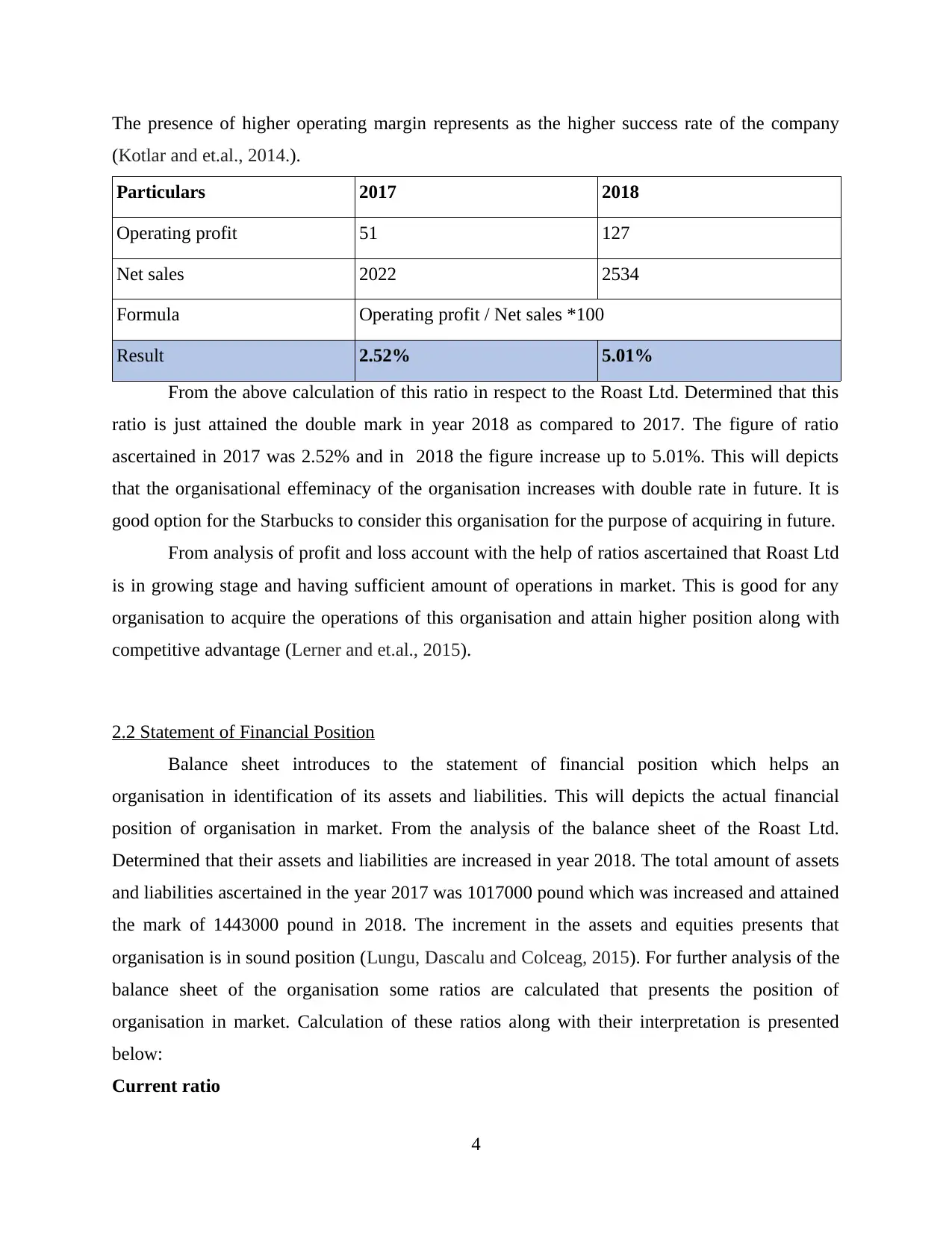
The presence of higher operating margin represents as the higher success rate of the company
(Kotlar and et.al., 2014.).
Particulars 2017 2018
Operating profit 51 127
Net sales 2022 2534
Formula Operating profit / Net sales *100
Result 2.52% 5.01%
From the above calculation of this ratio in respect to the Roast Ltd. Determined that this
ratio is just attained the double mark in year 2018 as compared to 2017. The figure of ratio
ascertained in 2017 was 2.52% and in 2018 the figure increase up to 5.01%. This will depicts
that the organisational effeminacy of the organisation increases with double rate in future. It is
good option for the Starbucks to consider this organisation for the purpose of acquiring in future.
From analysis of profit and loss account with the help of ratios ascertained that Roast Ltd
is in growing stage and having sufficient amount of operations in market. This is good for any
organisation to acquire the operations of this organisation and attain higher position along with
competitive advantage (Lerner and et.al., 2015).
2.2 Statement of Financial Position
Balance sheet introduces to the statement of financial position which helps an
organisation in identification of its assets and liabilities. This will depicts the actual financial
position of organisation in market. From the analysis of the balance sheet of the Roast Ltd.
Determined that their assets and liabilities are increased in year 2018. The total amount of assets
and liabilities ascertained in the year 2017 was 1017000 pound which was increased and attained
the mark of 1443000 pound in 2018. The increment in the assets and equities presents that
organisation is in sound position (Lungu, Dascalu and Colceag, 2015). For further analysis of the
balance sheet of the organisation some ratios are calculated that presents the position of
organisation in market. Calculation of these ratios along with their interpretation is presented
below:
Current ratio
4
(Kotlar and et.al., 2014.).
Particulars 2017 2018
Operating profit 51 127
Net sales 2022 2534
Formula Operating profit / Net sales *100
Result 2.52% 5.01%
From the above calculation of this ratio in respect to the Roast Ltd. Determined that this
ratio is just attained the double mark in year 2018 as compared to 2017. The figure of ratio
ascertained in 2017 was 2.52% and in 2018 the figure increase up to 5.01%. This will depicts
that the organisational effeminacy of the organisation increases with double rate in future. It is
good option for the Starbucks to consider this organisation for the purpose of acquiring in future.
From analysis of profit and loss account with the help of ratios ascertained that Roast Ltd
is in growing stage and having sufficient amount of operations in market. This is good for any
organisation to acquire the operations of this organisation and attain higher position along with
competitive advantage (Lerner and et.al., 2015).
2.2 Statement of Financial Position
Balance sheet introduces to the statement of financial position which helps an
organisation in identification of its assets and liabilities. This will depicts the actual financial
position of organisation in market. From the analysis of the balance sheet of the Roast Ltd.
Determined that their assets and liabilities are increased in year 2018. The total amount of assets
and liabilities ascertained in the year 2017 was 1017000 pound which was increased and attained
the mark of 1443000 pound in 2018. The increment in the assets and equities presents that
organisation is in sound position (Lungu, Dascalu and Colceag, 2015). For further analysis of the
balance sheet of the organisation some ratios are calculated that presents the position of
organisation in market. Calculation of these ratios along with their interpretation is presented
below:
Current ratio
4
Paraphrase This Document
Need a fresh take? Get an instant paraphrase of this document with our AI Paraphraser
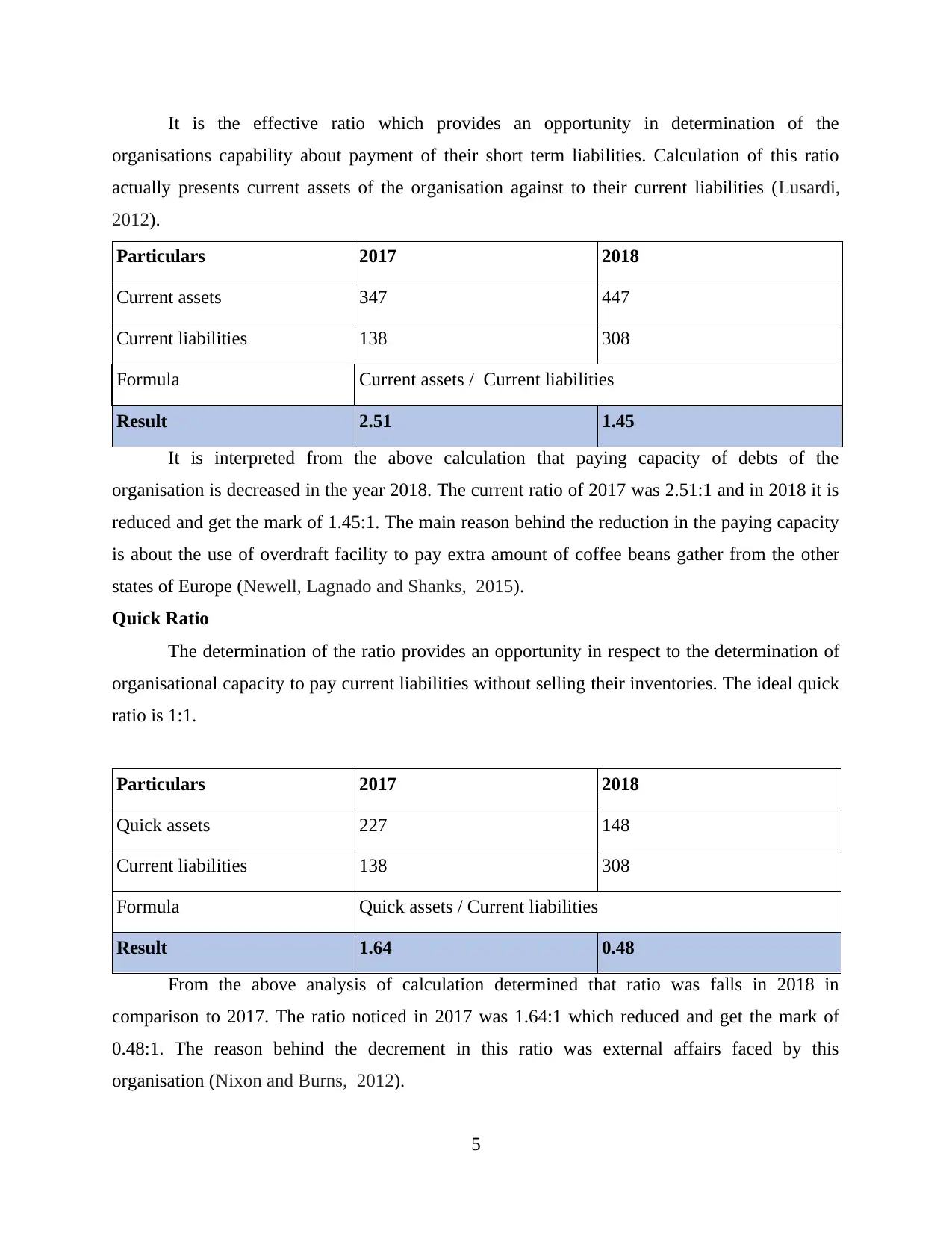
It is the effective ratio which provides an opportunity in determination of the
organisations capability about payment of their short term liabilities. Calculation of this ratio
actually presents current assets of the organisation against to their current liabilities (Lusardi,
2012).
Particulars 2017 2018
Current assets 347 447
Current liabilities 138 308
Formula Current assets / Current liabilities
Result 2.51 1.45
It is interpreted from the above calculation that paying capacity of debts of the
organisation is decreased in the year 2018. The current ratio of 2017 was 2.51:1 and in 2018 it is
reduced and get the mark of 1.45:1. The main reason behind the reduction in the paying capacity
is about the use of overdraft facility to pay extra amount of coffee beans gather from the other
states of Europe (Newell, Lagnado and Shanks, 2015).
Quick Ratio
The determination of the ratio provides an opportunity in respect to the determination of
organisational capacity to pay current liabilities without selling their inventories. The ideal quick
ratio is 1:1.
Particulars 2017 2018
Quick assets 227 148
Current liabilities 138 308
Formula Quick assets / Current liabilities
Result 1.64 0.48
From the above analysis of calculation determined that ratio was falls in 2018 in
comparison to 2017. The ratio noticed in 2017 was 1.64:1 which reduced and get the mark of
0.48:1. The reason behind the decrement in this ratio was external affairs faced by this
organisation (Nixon and Burns, 2012).
5
organisations capability about payment of their short term liabilities. Calculation of this ratio
actually presents current assets of the organisation against to their current liabilities (Lusardi,
2012).
Particulars 2017 2018
Current assets 347 447
Current liabilities 138 308
Formula Current assets / Current liabilities
Result 2.51 1.45
It is interpreted from the above calculation that paying capacity of debts of the
organisation is decreased in the year 2018. The current ratio of 2017 was 2.51:1 and in 2018 it is
reduced and get the mark of 1.45:1. The main reason behind the reduction in the paying capacity
is about the use of overdraft facility to pay extra amount of coffee beans gather from the other
states of Europe (Newell, Lagnado and Shanks, 2015).
Quick Ratio
The determination of the ratio provides an opportunity in respect to the determination of
organisational capacity to pay current liabilities without selling their inventories. The ideal quick
ratio is 1:1.
Particulars 2017 2018
Quick assets 227 148
Current liabilities 138 308
Formula Quick assets / Current liabilities
Result 1.64 0.48
From the above analysis of calculation determined that ratio was falls in 2018 in
comparison to 2017. The ratio noticed in 2017 was 1.64:1 which reduced and get the mark of
0.48:1. The reason behind the decrement in this ratio was external affairs faced by this
organisation (Nixon and Burns, 2012).
5
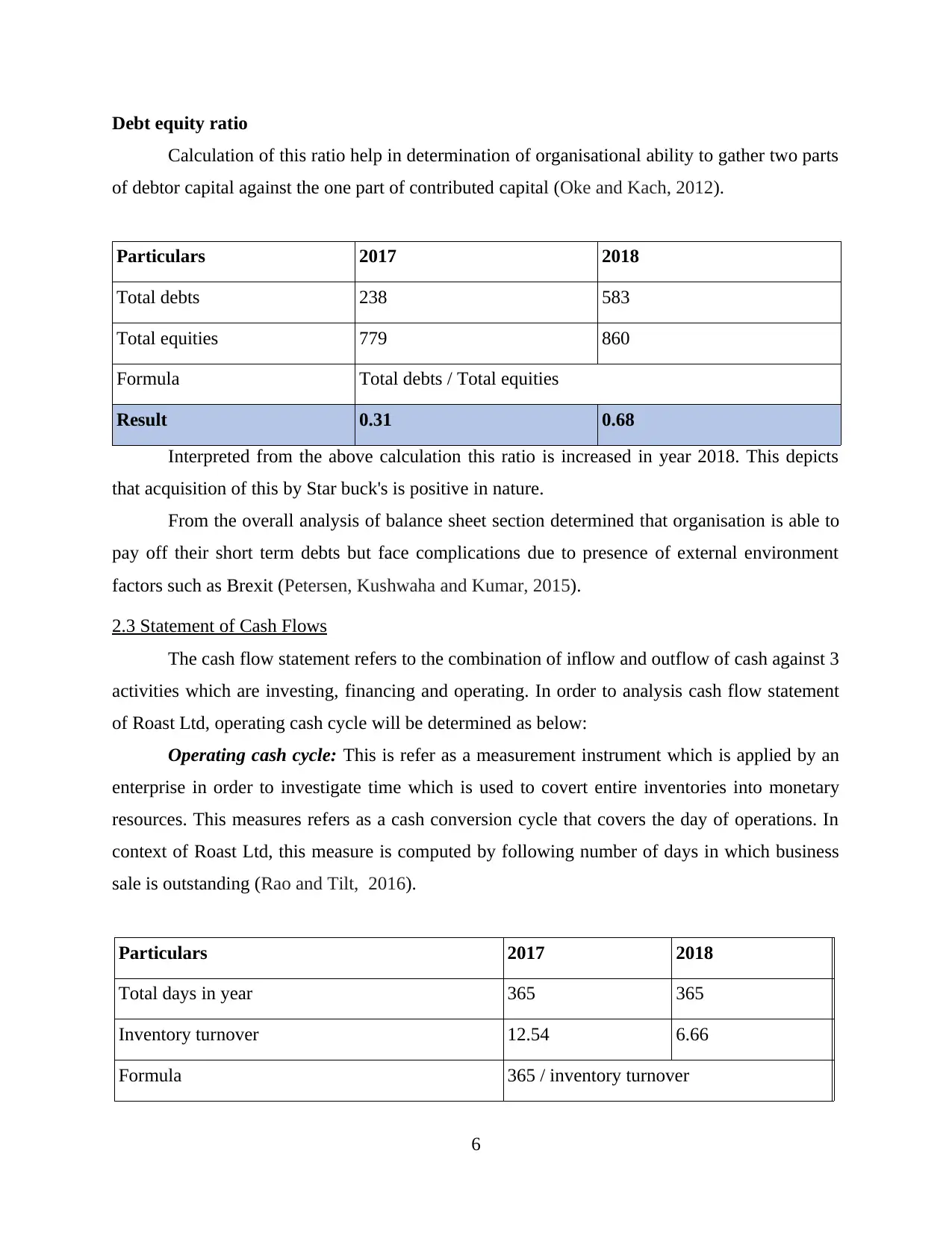
Debt equity ratio
Calculation of this ratio help in determination of organisational ability to gather two parts
of debtor capital against the one part of contributed capital (Oke and Kach, 2012).
Particulars 2017 2018
Total debts 238 583
Total equities 779 860
Formula Total debts / Total equities
Result 0.31 0.68
Interpreted from the above calculation this ratio is increased in year 2018. This depicts
that acquisition of this by Star buck's is positive in nature.
From the overall analysis of balance sheet section determined that organisation is able to
pay off their short term debts but face complications due to presence of external environment
factors such as Brexit (Petersen, Kushwaha and Kumar, 2015).
2.3 Statement of Cash Flows
The cash flow statement refers to the combination of inflow and outflow of cash against 3
activities which are investing, financing and operating. In order to analysis cash flow statement
of Roast Ltd, operating cash cycle will be determined as below:
Operating cash cycle: This is refer as a measurement instrument which is applied by an
enterprise in order to investigate time which is used to covert entire inventories into monetary
resources. This measures refers as a cash conversion cycle that covers the day of operations. In
context of Roast Ltd, this measure is computed by following number of days in which business
sale is outstanding (Rao and Tilt, 2016).
Particulars 2017 2018
Total days in year 365 365
Inventory turnover 12.54 6.66
Formula 365 / inventory turnover
6
Calculation of this ratio help in determination of organisational ability to gather two parts
of debtor capital against the one part of contributed capital (Oke and Kach, 2012).
Particulars 2017 2018
Total debts 238 583
Total equities 779 860
Formula Total debts / Total equities
Result 0.31 0.68
Interpreted from the above calculation this ratio is increased in year 2018. This depicts
that acquisition of this by Star buck's is positive in nature.
From the overall analysis of balance sheet section determined that organisation is able to
pay off their short term debts but face complications due to presence of external environment
factors such as Brexit (Petersen, Kushwaha and Kumar, 2015).
2.3 Statement of Cash Flows
The cash flow statement refers to the combination of inflow and outflow of cash against 3
activities which are investing, financing and operating. In order to analysis cash flow statement
of Roast Ltd, operating cash cycle will be determined as below:
Operating cash cycle: This is refer as a measurement instrument which is applied by an
enterprise in order to investigate time which is used to covert entire inventories into monetary
resources. This measures refers as a cash conversion cycle that covers the day of operations. In
context of Roast Ltd, this measure is computed by following number of days in which business
sale is outstanding (Rao and Tilt, 2016).
Particulars 2017 2018
Total days in year 365 365
Inventory turnover 12.54 6.66
Formula 365 / inventory turnover
6
You're viewing a preview
Unlock full access by subscribing today!

Days inventory outstanding 29.11 54.80
Total days in year 365 365
Receivable turnover 21.74 17.12
Formula 365 / receivable turnover
Days sale outstanding 16.79 21.32
Total days in year 365 365
Payable turnover 10.91 8.47
Formula 365 / payable turnover
Days payable outstanding 33.46 43.09
Formula
Days inventory outstanding + days sales
outstanding - days payable outstanding
Working notes:
Inventory turnover: Cost of sales / average inventory
Particulars 2017 2018
Cost of sales 1505 1990
Average inventory 120 299
Inventory turnover 12.54 6.66
Receivable turnover: Net sales / account receivables
Particulars 2017 2018
Net sales 2022 2534
Account receivables 93 148
Receivable turnover 21.74 17.12
Payable turnover: Cost of sales / account payable
Particulars 2017 2018
Cost of sales 1505 1990
7
Total days in year 365 365
Receivable turnover 21.74 17.12
Formula 365 / receivable turnover
Days sale outstanding 16.79 21.32
Total days in year 365 365
Payable turnover 10.91 8.47
Formula 365 / payable turnover
Days payable outstanding 33.46 43.09
Formula
Days inventory outstanding + days sales
outstanding - days payable outstanding
Working notes:
Inventory turnover: Cost of sales / average inventory
Particulars 2017 2018
Cost of sales 1505 1990
Average inventory 120 299
Inventory turnover 12.54 6.66
Receivable turnover: Net sales / account receivables
Particulars 2017 2018
Net sales 2022 2534
Account receivables 93 148
Receivable turnover 21.74 17.12
Payable turnover: Cost of sales / account payable
Particulars 2017 2018
Cost of sales 1505 1990
7
Paraphrase This Document
Need a fresh take? Get an instant paraphrase of this document with our AI Paraphraser

Account payables 138 235
Payable turnover 10.91 8.47
Calculation of operating cash cycle:
Particulars 2017 2018
Days inventory outstanding 29 55
Add: Days sales outstanding 17 21
Less: Days payable
outstanding 33 44
Operating cash cycle 13 32
Interpretation
From the above mentioned analysis or table, it has been seen that operating cash cycle of
company is 32 days in year 2018 and around 13 days in 2017. This means Roast Ltd takes
around a month to covert their raw material into amount of money.
Dividend policy
This refers as an effective strategy of enterprise which is completed based on top
management decision about the distribution of profits among their stakeholders. In case of Roast
Ltd, they have to decided as company not give dividend in year 2018 and according to the
researcher this is valid decision. This is essential for the Roast Ltd because it is a growing
organisation. They firstly invest in assets that can support to operate in effective manner rather
than distributing it to their all stakeholders.
After examine the cash flow, income statement and balance sheet of Roast Ltd it is
analysed that, it is a small organisation and has restricted value of profit as well as revenue but
when company comes to development and growth, the growth rate of that organisation is higher
which develops it more appropriate for Starbucks to acquire such organisation.
8
Payable turnover 10.91 8.47
Calculation of operating cash cycle:
Particulars 2017 2018
Days inventory outstanding 29 55
Add: Days sales outstanding 17 21
Less: Days payable
outstanding 33 44
Operating cash cycle 13 32
Interpretation
From the above mentioned analysis or table, it has been seen that operating cash cycle of
company is 32 days in year 2018 and around 13 days in 2017. This means Roast Ltd takes
around a month to covert their raw material into amount of money.
Dividend policy
This refers as an effective strategy of enterprise which is completed based on top
management decision about the distribution of profits among their stakeholders. In case of Roast
Ltd, they have to decided as company not give dividend in year 2018 and according to the
researcher this is valid decision. This is essential for the Roast Ltd because it is a growing
organisation. They firstly invest in assets that can support to operate in effective manner rather
than distributing it to their all stakeholders.
After examine the cash flow, income statement and balance sheet of Roast Ltd it is
analysed that, it is a small organisation and has restricted value of profit as well as revenue but
when company comes to development and growth, the growth rate of that organisation is higher
which develops it more appropriate for Starbucks to acquire such organisation.
8
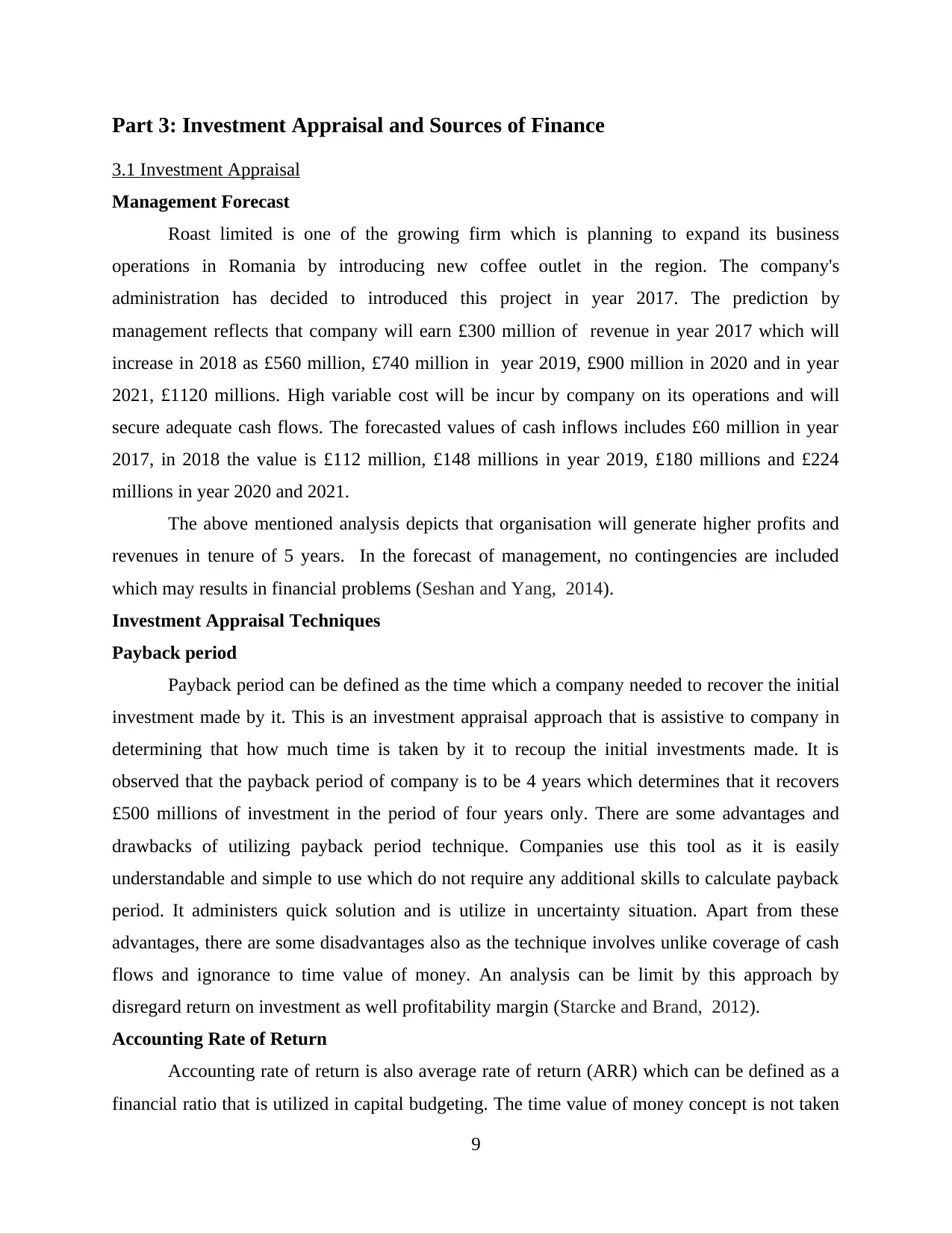
Part 3: Investment Appraisal and Sources of Finance
3.1 Investment Appraisal
Management Forecast
Roast limited is one of the growing firm which is planning to expand its business
operations in Romania by introducing new coffee outlet in the region. The company's
administration has decided to introduced this project in year 2017. The prediction by
management reflects that company will earn £300 million of revenue in year 2017 which will
increase in 2018 as £560 million, £740 million in year 2019, £900 million in 2020 and in year
2021, £1120 millions. High variable cost will be incur by company on its operations and will
secure adequate cash flows. The forecasted values of cash inflows includes £60 million in year
2017, in 2018 the value is £112 million, £148 millions in year 2019, £180 millions and £224
millions in year 2020 and 2021.
The above mentioned analysis depicts that organisation will generate higher profits and
revenues in tenure of 5 years. In the forecast of management, no contingencies are included
which may results in financial problems (Seshan and Yang, 2014).
Investment Appraisal Techniques
Payback period
Payback period can be defined as the time which a company needed to recover the initial
investment made by it. This is an investment appraisal approach that is assistive to company in
determining that how much time is taken by it to recoup the initial investments made. It is
observed that the payback period of company is to be 4 years which determines that it recovers
£500 millions of investment in the period of four years only. There are some advantages and
drawbacks of utilizing payback period technique. Companies use this tool as it is easily
understandable and simple to use which do not require any additional skills to calculate payback
period. It administers quick solution and is utilize in uncertainty situation. Apart from these
advantages, there are some disadvantages also as the technique involves unlike coverage of cash
flows and ignorance to time value of money. An analysis can be limit by this approach by
disregard return on investment as well profitability margin (Starcke and Brand, 2012).
Accounting Rate of Return
Accounting rate of return is also average rate of return (ARR) which can be defined as a
financial ratio that is utilized in capital budgeting. The time value of money concept is not taken
9
3.1 Investment Appraisal
Management Forecast
Roast limited is one of the growing firm which is planning to expand its business
operations in Romania by introducing new coffee outlet in the region. The company's
administration has decided to introduced this project in year 2017. The prediction by
management reflects that company will earn £300 million of revenue in year 2017 which will
increase in 2018 as £560 million, £740 million in year 2019, £900 million in 2020 and in year
2021, £1120 millions. High variable cost will be incur by company on its operations and will
secure adequate cash flows. The forecasted values of cash inflows includes £60 million in year
2017, in 2018 the value is £112 million, £148 millions in year 2019, £180 millions and £224
millions in year 2020 and 2021.
The above mentioned analysis depicts that organisation will generate higher profits and
revenues in tenure of 5 years. In the forecast of management, no contingencies are included
which may results in financial problems (Seshan and Yang, 2014).
Investment Appraisal Techniques
Payback period
Payback period can be defined as the time which a company needed to recover the initial
investment made by it. This is an investment appraisal approach that is assistive to company in
determining that how much time is taken by it to recoup the initial investments made. It is
observed that the payback period of company is to be 4 years which determines that it recovers
£500 millions of investment in the period of four years only. There are some advantages and
drawbacks of utilizing payback period technique. Companies use this tool as it is easily
understandable and simple to use which do not require any additional skills to calculate payback
period. It administers quick solution and is utilize in uncertainty situation. Apart from these
advantages, there are some disadvantages also as the technique involves unlike coverage of cash
flows and ignorance to time value of money. An analysis can be limit by this approach by
disregard return on investment as well profitability margin (Starcke and Brand, 2012).
Accounting Rate of Return
Accounting rate of return is also average rate of return (ARR) which can be defined as a
financial ratio that is utilized in capital budgeting. The time value of money concept is not taken
9
You're viewing a preview
Unlock full access by subscribing today!
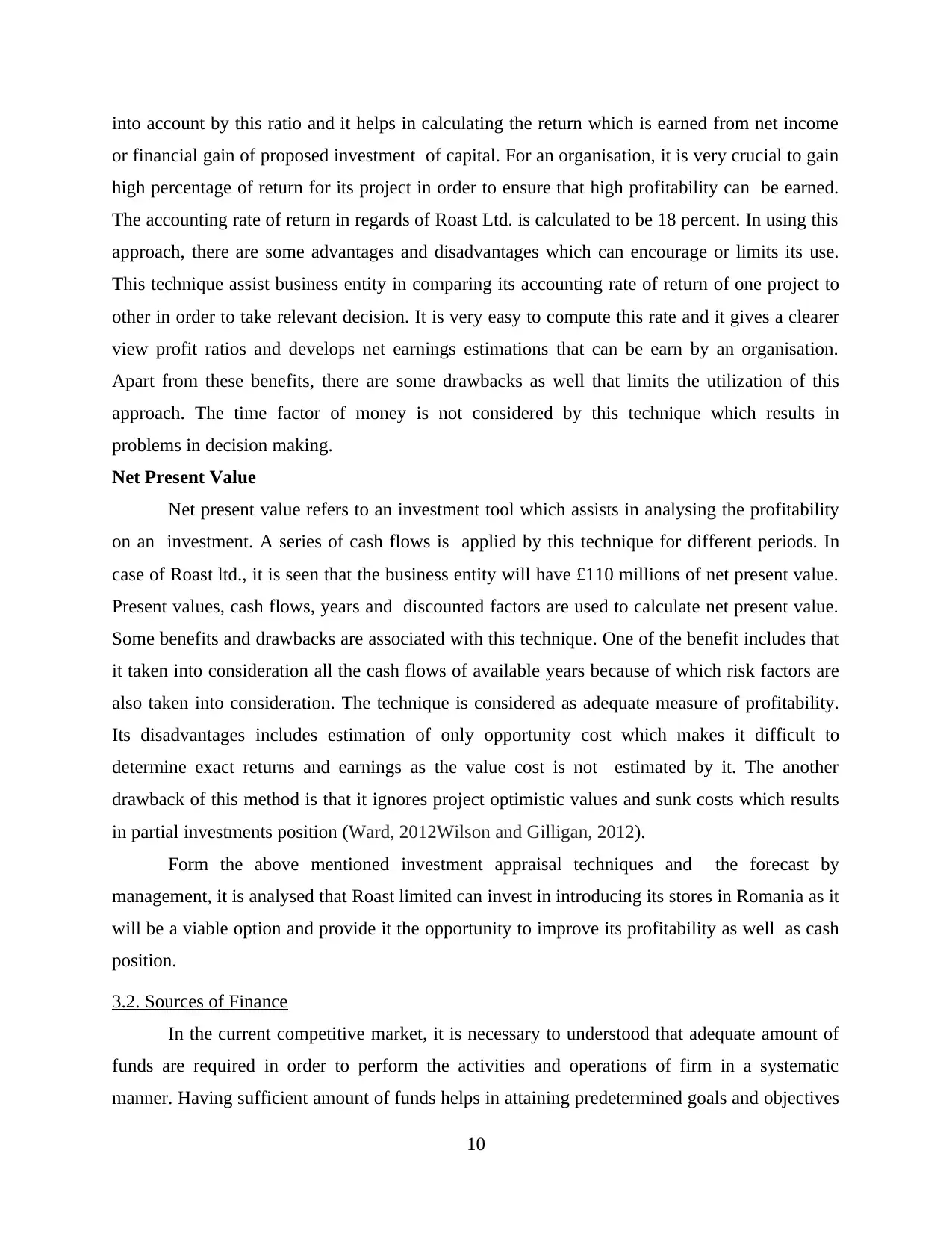
into account by this ratio and it helps in calculating the return which is earned from net income
or financial gain of proposed investment of capital. For an organisation, it is very crucial to gain
high percentage of return for its project in order to ensure that high profitability can be earned.
The accounting rate of return in regards of Roast Ltd. is calculated to be 18 percent. In using this
approach, there are some advantages and disadvantages which can encourage or limits its use.
This technique assist business entity in comparing its accounting rate of return of one project to
other in order to take relevant decision. It is very easy to compute this rate and it gives a clearer
view profit ratios and develops net earnings estimations that can be earn by an organisation.
Apart from these benefits, there are some drawbacks as well that limits the utilization of this
approach. The time factor of money is not considered by this technique which results in
problems in decision making.
Net Present Value
Net present value refers to an investment tool which assists in analysing the profitability
on an investment. A series of cash flows is applied by this technique for different periods. In
case of Roast ltd., it is seen that the business entity will have £110 millions of net present value.
Present values, cash flows, years and discounted factors are used to calculate net present value.
Some benefits and drawbacks are associated with this technique. One of the benefit includes that
it taken into consideration all the cash flows of available years because of which risk factors are
also taken into consideration. The technique is considered as adequate measure of profitability.
Its disadvantages includes estimation of only opportunity cost which makes it difficult to
determine exact returns and earnings as the value cost is not estimated by it. The another
drawback of this method is that it ignores project optimistic values and sunk costs which results
in partial investments position (Ward, 2012Wilson and Gilligan, 2012).
Form the above mentioned investment appraisal techniques and the forecast by
management, it is analysed that Roast limited can invest in introducing its stores in Romania as it
will be a viable option and provide it the opportunity to improve its profitability as well as cash
position.
3.2. Sources of Finance
In the current competitive market, it is necessary to understood that adequate amount of
funds are required in order to perform the activities and operations of firm in a systematic
manner. Having sufficient amount of funds helps in attaining predetermined goals and objectives
10
or financial gain of proposed investment of capital. For an organisation, it is very crucial to gain
high percentage of return for its project in order to ensure that high profitability can be earned.
The accounting rate of return in regards of Roast Ltd. is calculated to be 18 percent. In using this
approach, there are some advantages and disadvantages which can encourage or limits its use.
This technique assist business entity in comparing its accounting rate of return of one project to
other in order to take relevant decision. It is very easy to compute this rate and it gives a clearer
view profit ratios and develops net earnings estimations that can be earn by an organisation.
Apart from these benefits, there are some drawbacks as well that limits the utilization of this
approach. The time factor of money is not considered by this technique which results in
problems in decision making.
Net Present Value
Net present value refers to an investment tool which assists in analysing the profitability
on an investment. A series of cash flows is applied by this technique for different periods. In
case of Roast ltd., it is seen that the business entity will have £110 millions of net present value.
Present values, cash flows, years and discounted factors are used to calculate net present value.
Some benefits and drawbacks are associated with this technique. One of the benefit includes that
it taken into consideration all the cash flows of available years because of which risk factors are
also taken into consideration. The technique is considered as adequate measure of profitability.
Its disadvantages includes estimation of only opportunity cost which makes it difficult to
determine exact returns and earnings as the value cost is not estimated by it. The another
drawback of this method is that it ignores project optimistic values and sunk costs which results
in partial investments position (Ward, 2012Wilson and Gilligan, 2012).
Form the above mentioned investment appraisal techniques and the forecast by
management, it is analysed that Roast limited can invest in introducing its stores in Romania as it
will be a viable option and provide it the opportunity to improve its profitability as well as cash
position.
3.2. Sources of Finance
In the current competitive market, it is necessary to understood that adequate amount of
funds are required in order to perform the activities and operations of firm in a systematic
manner. Having sufficient amount of funds helps in attaining predetermined goals and objectives
10
Paraphrase This Document
Need a fresh take? Get an instant paraphrase of this document with our AI Paraphraser

of company in an effective and efficient way. In relation to Roast Ltd., firm is planning to
operate its business activities in Italy for which it requires sufficient amount of finance.
Numerous ways are there that can be assistive for company in raising funds by which it can
improve its efforts for achieving the targets. There are various sources that can be utilize by firm
for raising money that helps in operating its business activities successfully. Some of the sources
are mentioned below:
Angel Investors:
Angel investor is an individual with high net worth who provides financial support to
entrepreneurs or small start ups, in exchange for ownership equity within the business entity. In
this process, firm tries to search a investor who can invest money in company. In recent years,
this concept is growing drastically in which high returns are expected by the investors. These
investors invests money in venture and are ready to take risk by involving themselves in the
process of business taking. There are some advantages and disadvantages of this source of
finance which are mentioned below:
Advantage:
Angel investors assists business entities by providing them better advices that can
supports company in attaining its goals.
Disadvantage:
The main disadvantage of this source of finance is that in this, business entity is forced to
delegate authority or power to another person.
Bank Loan:
In order to raise funds, bank loan is the most appropriate and preferable option for a
business entity. The prime reason behind adopting this particular source of fund is that it enables
company to make repayment of loan as per their convenience. Bank provides a certain period of
time to borrower as per their choice to repay the loan in easy instalments which reduces their
pressure to make single payment of entire amount. Bank provides loan to the individual against
to some collateral security and a interest amount is included in it which the borrower have to
pay. This is the easiest way for business to acquire funds and allows it to expand its business
operations at large scale. One crucial thing which is required to understand in relation to bank
loan is that the authority to take final decision in any situation will be on bank. They decide
11
operate its business activities in Italy for which it requires sufficient amount of finance.
Numerous ways are there that can be assistive for company in raising funds by which it can
improve its efforts for achieving the targets. There are various sources that can be utilize by firm
for raising money that helps in operating its business activities successfully. Some of the sources
are mentioned below:
Angel Investors:
Angel investor is an individual with high net worth who provides financial support to
entrepreneurs or small start ups, in exchange for ownership equity within the business entity. In
this process, firm tries to search a investor who can invest money in company. In recent years,
this concept is growing drastically in which high returns are expected by the investors. These
investors invests money in venture and are ready to take risk by involving themselves in the
process of business taking. There are some advantages and disadvantages of this source of
finance which are mentioned below:
Advantage:
Angel investors assists business entities by providing them better advices that can
supports company in attaining its goals.
Disadvantage:
The main disadvantage of this source of finance is that in this, business entity is forced to
delegate authority or power to another person.
Bank Loan:
In order to raise funds, bank loan is the most appropriate and preferable option for a
business entity. The prime reason behind adopting this particular source of fund is that it enables
company to make repayment of loan as per their convenience. Bank provides a certain period of
time to borrower as per their choice to repay the loan in easy instalments which reduces their
pressure to make single payment of entire amount. Bank provides loan to the individual against
to some collateral security and a interest amount is included in it which the borrower have to
pay. This is the easiest way for business to acquire funds and allows it to expand its business
operations at large scale. One crucial thing which is required to understand in relation to bank
loan is that the authority to take final decision in any situation will be on bank. They decide
11

whether to provide loan to individual or not. Some advantages and disadvantages are associated
with this sources of finance which are mentioned below:
Advantage:
The main advantage of bank loan is that once it is approved, there is no interference of
bank that how the provided fund is used.
Disadvantage:
The disadvantage of bank loan is that borrower requires to complete various formalities
and lengthiest paper work which makes the process of taking loan very complicated.
From the above mentioned sources of finance, bank loan is the most appropriate source
for Roast Ltd. to raise adequate amount of funds. If the engagement of third party is available,
the business entity will not be able to perform its activities freely. So, if it takes bank loan, it
would be beneficial for Roast Ltd. as it reduces its pressure and enables it to repay the loan
easily by paying monthly instalments. Bank loan will provides flexibility to company to pay loan
as per their convenience along with low interest rates in comparison to other sources of funds.
12
with this sources of finance which are mentioned below:
Advantage:
The main advantage of bank loan is that once it is approved, there is no interference of
bank that how the provided fund is used.
Disadvantage:
The disadvantage of bank loan is that borrower requires to complete various formalities
and lengthiest paper work which makes the process of taking loan very complicated.
From the above mentioned sources of finance, bank loan is the most appropriate source
for Roast Ltd. to raise adequate amount of funds. If the engagement of third party is available,
the business entity will not be able to perform its activities freely. So, if it takes bank loan, it
would be beneficial for Roast Ltd. as it reduces its pressure and enables it to repay the loan
easily by paying monthly instalments. Bank loan will provides flexibility to company to pay loan
as per their convenience along with low interest rates in comparison to other sources of funds.
12
You're viewing a preview
Unlock full access by subscribing today!

REFERENCES
Books and Journals
Correia, T., Dussault, G. and Pontes, C., 2015. The impact of the financial crisis on human
resources for health policies in three southern-Europe countries. Health Policy. 119(12).
pp.1600-1605.
Finke, M., 2013. Financial Advice: Does it make a difference?. The market for retirement
financial advice. pp.229-48.
Gal, T., Stewart, T. and Hanne, T. eds., 2013. Multicriteria decision making: advances in MCDM
models, algorithms, theory, and applications (Vol. 21). Springer Science & Business
Media.
Govindan, K., Rajendran, S., Sarkis, J. and Murugesan, P., 2015. Multi criteria decision making
approaches for green supplier evaluation and selection: a literature review. Journal of
Cleaner Production. 98. pp.66-83.
Kliger, D. and Gilad, D., 2012. Red light, green light: Color priming in financial decisions. The
Journal of Socio-Economics. 41(5). pp.738-745.
Kotlar, J. and et.al., 2014. Profitability goals, control goals, and the R & D investment decisions
of family and nonfamily firms. Journal of Product Innovation Management. 31(6).
pp.1128-1145.
Lerner and et.al., 2015. Emotion and decision making. Annual review of psychology. 66. pp.799-
823.
Lungu, C.I., Dascalu, C. and Colceag, F. eds., 2015. Green accounting initiatives and strategies
for sustainable development. Business Science Reference.
Lusardi, A., 2012. Financial literacy and financial decision-making in older
adults. Generations. 36(2). pp.25-32.
Newell, B.R., Lagnado, D.A. and Shanks, D.R., 2015. Straight choices: The psychology of
decision making. Psychology Press.
Nixon, B. and Burns, J., 2012. The paradox of strategic management accounting. Management
Accounting Research. 23(4). pp.229-244.
Oke, A. and Kach, A., 2012. Linking sourcing and collaborative strategies to financial
performance: The role of operational innovation. Journal of Purchasing and Supply
Management. 18(1). pp.46-59.
Petersen, J.A., Kushwaha, T. and Kumar, V., 2015. Marketing communication strategies and
consumer financial decision making: The role of national culture. Journal of
Marketing. 79(1). pp.44-63.
Rao, K. and Tilt, C., 2016. Board composition and corporate social responsibility: The role of
diversity, gender, strategy and decision making. Journal of Business Ethics. 138(2).
pp.327-347.
Seshan, G. and Yang, D., 2014. Motivating migrants: A field experiment on financial decision-
making in transnational households. Journal of Development Economics. 108. pp.119-
127.
Starcke, K. and Brand, M., 2012. Decision making under stress: a selective review. Neuroscience
& Biobehavioral Reviews. 36(4). pp.1228-1248.
Ward, K., 2012. Strategic management accounting. Routledge.
Wilson, R.M. and Gilligan, C., 2012. Strategic marketing management. Routledge.
Online
13
Books and Journals
Correia, T., Dussault, G. and Pontes, C., 2015. The impact of the financial crisis on human
resources for health policies in three southern-Europe countries. Health Policy. 119(12).
pp.1600-1605.
Finke, M., 2013. Financial Advice: Does it make a difference?. The market for retirement
financial advice. pp.229-48.
Gal, T., Stewart, T. and Hanne, T. eds., 2013. Multicriteria decision making: advances in MCDM
models, algorithms, theory, and applications (Vol. 21). Springer Science & Business
Media.
Govindan, K., Rajendran, S., Sarkis, J. and Murugesan, P., 2015. Multi criteria decision making
approaches for green supplier evaluation and selection: a literature review. Journal of
Cleaner Production. 98. pp.66-83.
Kliger, D. and Gilad, D., 2012. Red light, green light: Color priming in financial decisions. The
Journal of Socio-Economics. 41(5). pp.738-745.
Kotlar, J. and et.al., 2014. Profitability goals, control goals, and the R & D investment decisions
of family and nonfamily firms. Journal of Product Innovation Management. 31(6).
pp.1128-1145.
Lerner and et.al., 2015. Emotion and decision making. Annual review of psychology. 66. pp.799-
823.
Lungu, C.I., Dascalu, C. and Colceag, F. eds., 2015. Green accounting initiatives and strategies
for sustainable development. Business Science Reference.
Lusardi, A., 2012. Financial literacy and financial decision-making in older
adults. Generations. 36(2). pp.25-32.
Newell, B.R., Lagnado, D.A. and Shanks, D.R., 2015. Straight choices: The psychology of
decision making. Psychology Press.
Nixon, B. and Burns, J., 2012. The paradox of strategic management accounting. Management
Accounting Research. 23(4). pp.229-244.
Oke, A. and Kach, A., 2012. Linking sourcing and collaborative strategies to financial
performance: The role of operational innovation. Journal of Purchasing and Supply
Management. 18(1). pp.46-59.
Petersen, J.A., Kushwaha, T. and Kumar, V., 2015. Marketing communication strategies and
consumer financial decision making: The role of national culture. Journal of
Marketing. 79(1). pp.44-63.
Rao, K. and Tilt, C., 2016. Board composition and corporate social responsibility: The role of
diversity, gender, strategy and decision making. Journal of Business Ethics. 138(2).
pp.327-347.
Seshan, G. and Yang, D., 2014. Motivating migrants: A field experiment on financial decision-
making in transnational households. Journal of Development Economics. 108. pp.119-
127.
Starcke, K. and Brand, M., 2012. Decision making under stress: a selective review. Neuroscience
& Biobehavioral Reviews. 36(4). pp.1228-1248.
Ward, K., 2012. Strategic management accounting. Routledge.
Wilson, R.M. and Gilligan, C., 2012. Strategic marketing management. Routledge.
Online
13
Paraphrase This Document
Need a fresh take? Get an instant paraphrase of this document with our AI Paraphraser
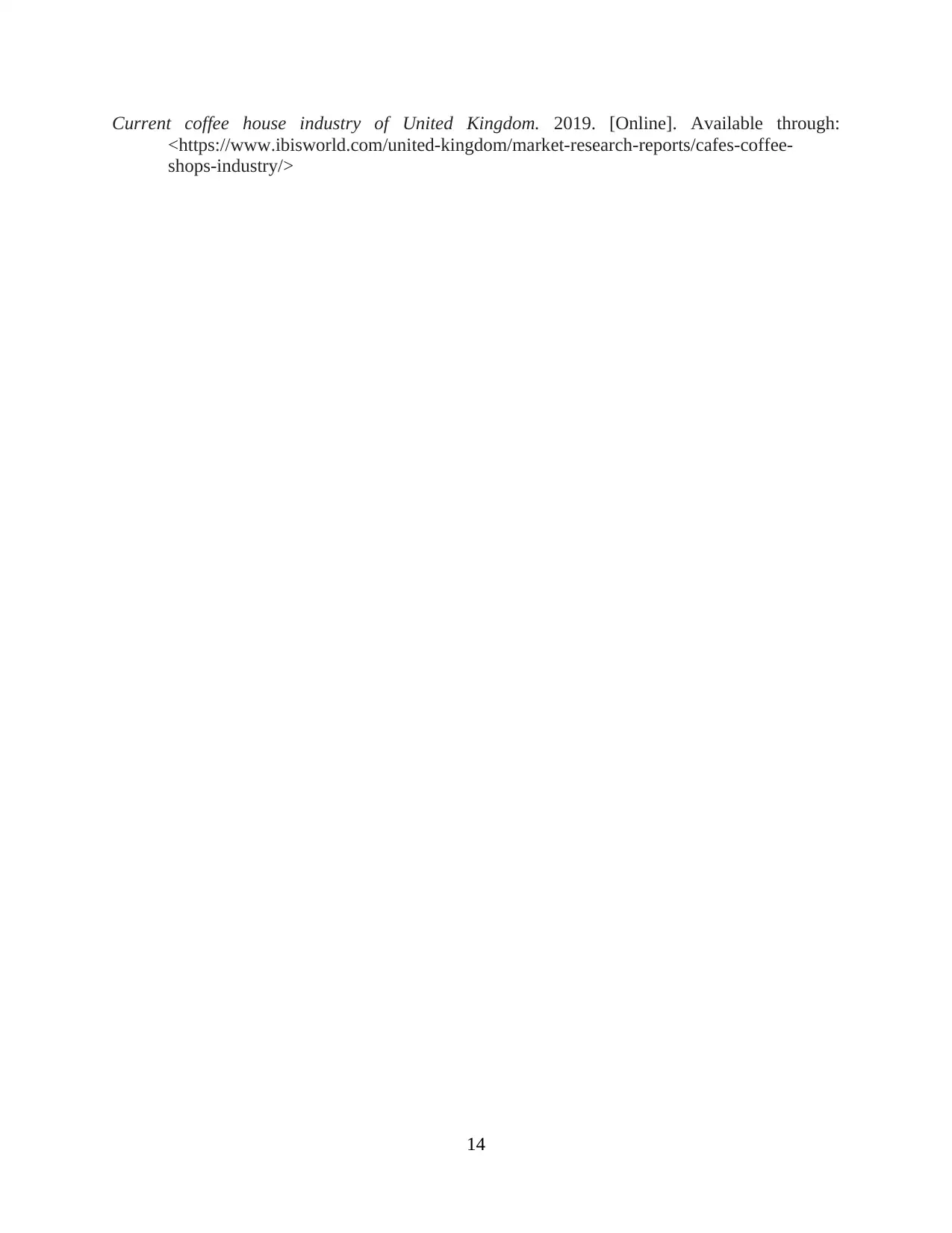
Current coffee house industry of United Kingdom. 2019. [Online]. Available through:
<https://www.ibisworld.com/united-kingdom/market-research-reports/cafes-coffee-
shops-industry/>
14
<https://www.ibisworld.com/united-kingdom/market-research-reports/cafes-coffee-
shops-industry/>
14
1 out of 17
Related Documents
Your All-in-One AI-Powered Toolkit for Academic Success.
+13062052269
info@desklib.com
Available 24*7 on WhatsApp / Email
![[object Object]](/_next/static/media/star-bottom.7253800d.svg)
Unlock your academic potential
© 2024 | Zucol Services PVT LTD | All rights reserved.





